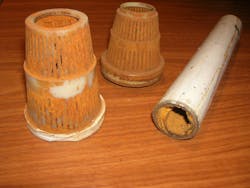Less Hardness, Better Health
About the author: Kamil Celinski is product manager for Aquafilter Europe Ltd. Celinski can be reached at [email protected] or +48.42.613.1931.
One of the most serious tap water problems faced by the country of Poland is the high rate of hardness in natural water sources. The term “hard water” references the abundance of minerals, particularly calcium and magnesium, found in water reserves. In other words, when water contains a significant amount of magnesium and calcium, it is described as hard.
Hard water clogs pipes and hinders the foaming of soaps and other detergents in water. Water hardness increases with increasing levels of calcium and magnesium salts dissolved in water. Magnesium and calcium are present in the form of positive ions. Due to the variable nature of salt presence in water, the causes of water hardness are separated into two categories: carbonate (transient) and non-carbonate (permanent). Unfortunately, both types are extremely prevalent in Poland.
Hard Water Risks
The consumption and/or use of hard water may adversely affect the human body. The most common symptoms include:
- Excessive dryness of the skin and hair;
- Formation of kidney stones (nephrolithiasis) or gallbladder stones; and
- Diseases of the digestive system.
Hard water also is one of the most common issues associated with the rapid destruction of household appliances such as washing machines, dishwashers, and booster devices or boilers — a problem that is all too common in Poland. Stone deposits on heating elements can cause a significant strain on a device and a subsequent increase in energy use.
Softening Options
The term softening refers to a technique that is used to remove hardness ions. In most cases, these are calcium and magnesium ions — although the softening process also can be employed to remove some iron ions. The best way to soften water is to use a water softener and connect it directly to the entrance of the pipeline.
There are many softening devices on the market, not necessarily related to the filtration of water, that are able to reduce water hardness. These include magnets. Magnetic softening devices are applied to the water pipe as flowing water passes, with the intention of removing calcium and magnesium ions. Despite the low cost of such devices, they often are less able to remove higher degrees of water hardness.
Ions contributing to water hardness may be removed using softening cartridges attached to pipe bodies. This solution can provide a better quality of water than magnetic systems, especially in Poland, where ion levels are high. It is not as cost-effective when compared with the former option, however, as cartridges quickly lose their ability to soften and require frequent replacement.
A third option that has proven effective in Poland is the ion exchange water softener. Such a water softening device (plasticizer) is a specific ion exchanger designed to remove positive ions. These softeners mainly target and remove calcium and magnesium ions, which are sometimes referred to as hardness minerals. The water softener collects the hardness minerals in a tank and flushes them to a collection drain. In contrast to cartridges, these softeners can be repeatedly renewed through the flushing of a saltwater solution through a secondary reservoir. In this way, the life of the bed in the softener can be as long as five to seven years.
Softeners effectively reduce hardness. Nevertheless, each system should be individually tailored to each client, and what works well in one country may not be the most effective solution in another. The decisive factor for the type of water softener needed is the level of hardness, with a benchmark at cubic meters per day. After installing the appropriate system with proper configuration, hardness will be close to or equal to zero
Download: Here
